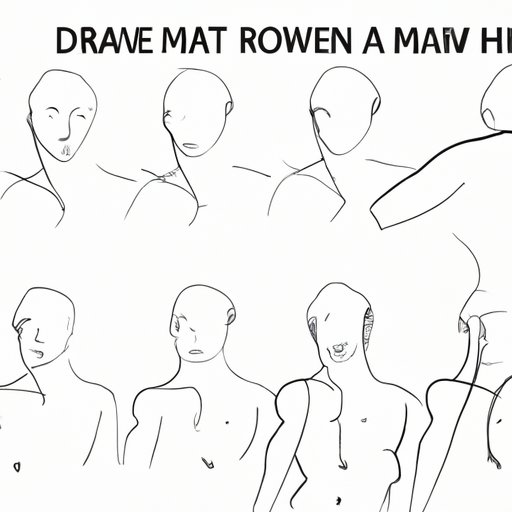
Introduction
If you’re a budding artist or just someone who loves to draw, learning how to draw a man can be a fun and rewarding experience. Being able to capture the nuances of the male form can help you create captivating artwork that showcases your skills and creativity. Whether you’re looking to improve your art skills or just try something new, this article will provide you with a comprehensive guide on how to draw a man.
Step-by-step guide
The key to drawing a man is to start with the most basic shapes and proportions and gradually add more details. Begin by drawing a circle for the head, an oval for the torso, and rectangular shapes for the limbs. Once you have these basic shapes, start adding more details such as the facial features, muscles, and clothing.
When drawing facial features, pay close attention to the placement and size of the eyes, nose, and mouth. Use references or a mirror to observe how these features are arranged and how they interact with one another. Similarly, when drawing the body, consider how the muscles and bones interact to create different poses and movements.
When drawing clothing, focus on the folds and creases to create a sense of movement and realism. Use reference images or real-life observations to capture the different textures and patterns of different fabrics.
Video tutorial
If you prefer a more interactive and immersive way of learning, consider watching a video tutorial on how to draw a man. There are many free tutorials available online that can guide you through the process step-by-step. Make sure to choose a tutorial that is clear, easy-to-follow, and offers plenty of tips and tricks.
For best results, follow along with the tutorial and practice the techniques demonstrated until you feel comfortable and confident in your ability to draw a man.
Learning resources
To take your drawing skills to the next level, consider investing in some learning resources such as books or online courses. These can provide you with a more structured and in-depth approach to learning how to draw a man. Some popular resources include:
- ‘Drawing the Head and Figure’ by Jack Hamm
- ‘Anatomy for the Artist’ by Sarah Simblet
- Online courses on Udemy or Skillshare
Whatever resource you choose, make sure it’s relevant to your skill level and offers plenty of practice exercises and guidance.
Easy techniques
If you’re just starting out with drawing a man, there are a few simple techniques that can help you get started:
- Break down complex shapes into simpler elements
- Start with basic shapes and lines before adding details
- Focus on one feature at a time (e.g. draw the face before the body)
By using these techniques, you can avoid feeling overwhelmed and gradually build up your skills and confidence over time.
Inspiration
If you’re looking for some inspiration for your drawings, consider checking out the work of professional artists who specialize in drawing men. Some popular examples include:
- Michelangelo’s ‘David’
- Leonardo da Vinci’s sketches of male anatomy
- Modern artists such as Andrew Loomis, John Singer Sargent, or Robert Liberace
What’s great about these examples is that they showcase a variety of styles and techniques, from classical realism to dynamic sketches and impressionism. Take inspiration from these artworks and experiment with your own style.
Common mistakes
While learning how to draw a man, it’s common to make mistakes. Some of the most common mistakes include:
- Disproportionate features (e.g. eyes that are too big or limbs that are too long)
- Stiff and unrealistic poses
- Lack of detail or attention to texture
To avoid these mistakes, practice observing the male form in different poses and angles. Use references or real-life observations to capture the unique features and characteristics of the male figure. Don’t be afraid to experiment with different poses and styles until you find what works best for you.
Conclusion
Learning how to draw a man takes practice, patience, and dedication. By following the steps outlined in this article, experimenting with different techniques, and seeking inspiration and guidance from professional artists, you can improve your drawing skills and create captivating artwork that showcases your creativity and talent. Remember to practice regularly and never stop learning and exploring your artistic potential.





